



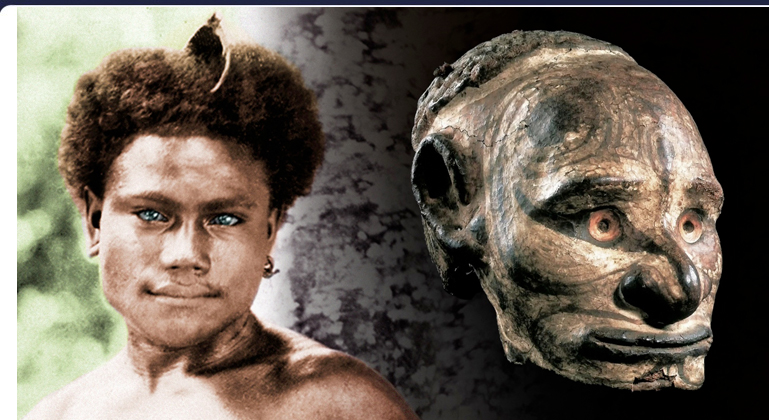
Resonance in Exoplanetary Hybridization
Worship of Reptilian Giants Linked with Exoplanetary Interspeciation
by Alex Putney for Human-Resonance.org
October 11, 2015
The nascent science of genetics has only begun to unravel the complexities of the human genome, in all its billions of unique expressions walking the planet today. New DNA extraction techniques extend the reach of possibility for sequencing ancient humanoid specimens with especially non-human craniofacial features that indicate exoplanetary hybridization of dynastic bloodlines. Just look at the giant faces of Angkor (below).
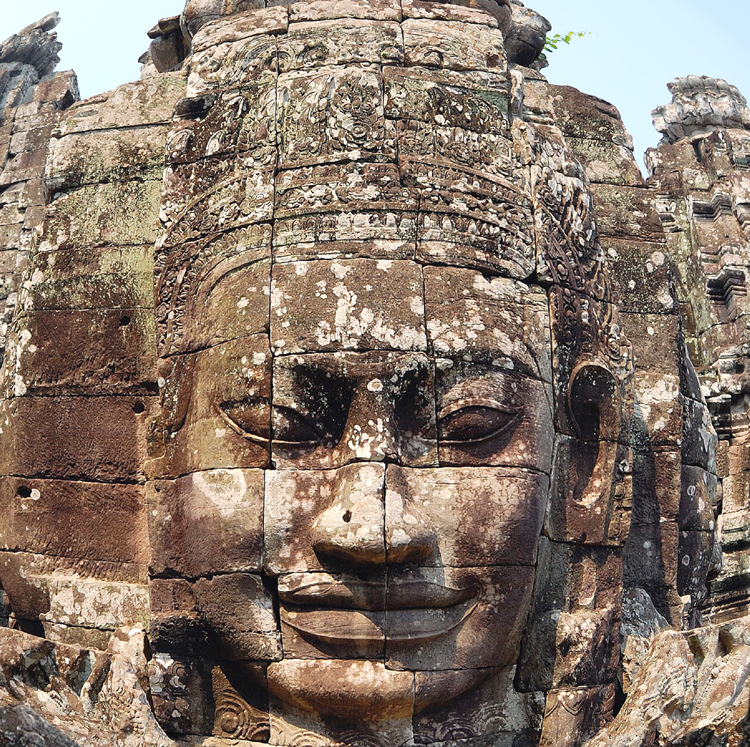
The astonishing complexity of human genetic variation cannot be easily explained by slow migratory patterns and occasional mutations along the way, as so many theoretical models maintain. Our growing technological capability for supercomputation is now exposing hybridization patterns within various human lineages based on the unmistakable presence of Neanderthal and Denisovan genes in modern populations.
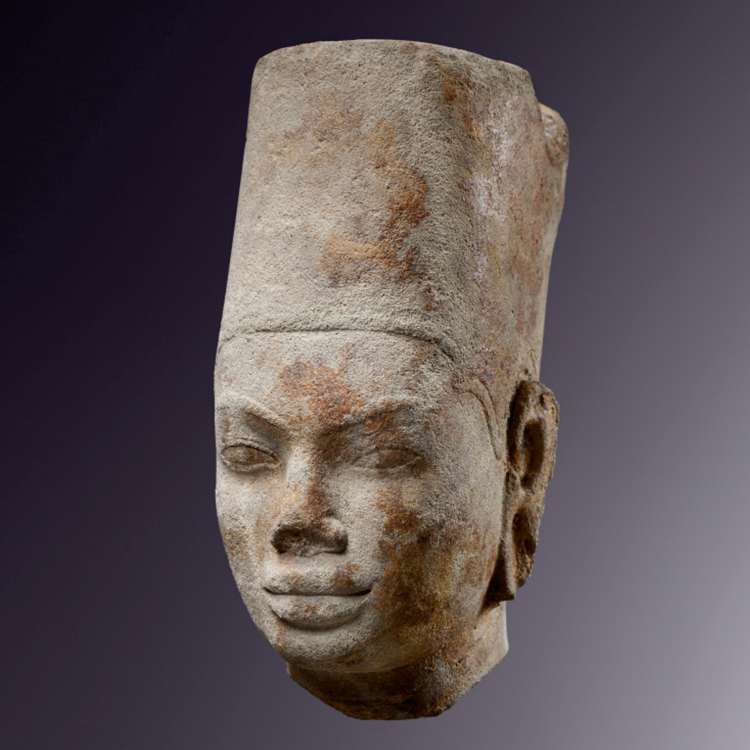
However, the stark reality of exoplanetary mass hybridization of the global terrestrial human population is now becoming evident as compartmentally suppressed data emerges in the digital online archive for public use. Government control of DNA sequencing and analysis technologies has been strictly maintained through academic fronts that actively undermine genuine research into censored topics such as this.
Widely accepted hybridization dynamics that account for several percent of the human genome in various haplogroups do not recognize the presence of exoplanetary gene flow into the terrestrial human genetic domain, despite the assertions of indigenous Elders around the world that know this is the case.
Genetic sequences and analyses of ancient dynastic rulers from all over the world are kept as state secrets, yet clear patterns have been preserved in sacred artwork from those periods that reveal what is being hidden, and offer strong indications as to why that is the case. One must look closely at the evidence.
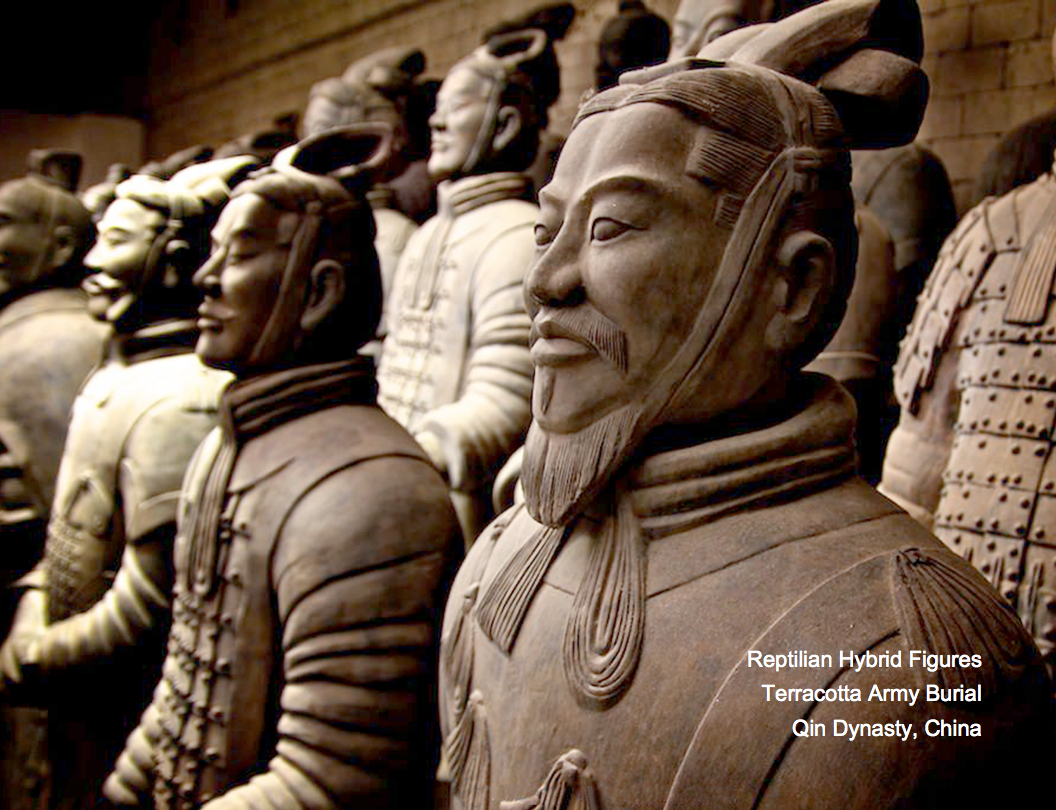
Over 6,000 life-size terracotta portrait figures were interred with China's Emperor Qin Shi Huang, whose great significance has not been entirely understood. Named the Terracotta Army, this monumental artwork accomplished by clay sculptors contains such detailed individual workmanship that even the horses and all their tackle are perfectly represented. Perfect likeness was crucial to preserving the extraordinary facial features of the Qin dynasty warriors to record their special genetic heritage as reptilian hybrids (above).
Each of the thousands of full-size terracotta figures displays an extremely square head, or brachycephalic, with large ears, a square jaw, heavy brow ridges and very large eyes that turn up at their outer corners. These unusual details exactly match the exotic features of megalithic faces adorning the Angkor complex.
Much older than both the Terracotta Army and the Angkor temple complex, megalithic stone heads were also produced by the Olmec culture of present-day Mexico, that preceded the rise of the Maya by several millennia. While the size of these Olmec heads corresponds closely to those of the Angkor temple façades, distinctively African faces are immediately evident. The Olmec heads are artificial magnetic basalt.
The megalithic Olmec faces display large eyes, broad cheekbones, flat noses, heavy brows and square jaws with wide mouths and large undulating lips, rendered with the same exact outline feature seen on the giant faces at Angkor. A square glyph over the third eye chakra reads: Indra , meaning "Jupiter" (below).
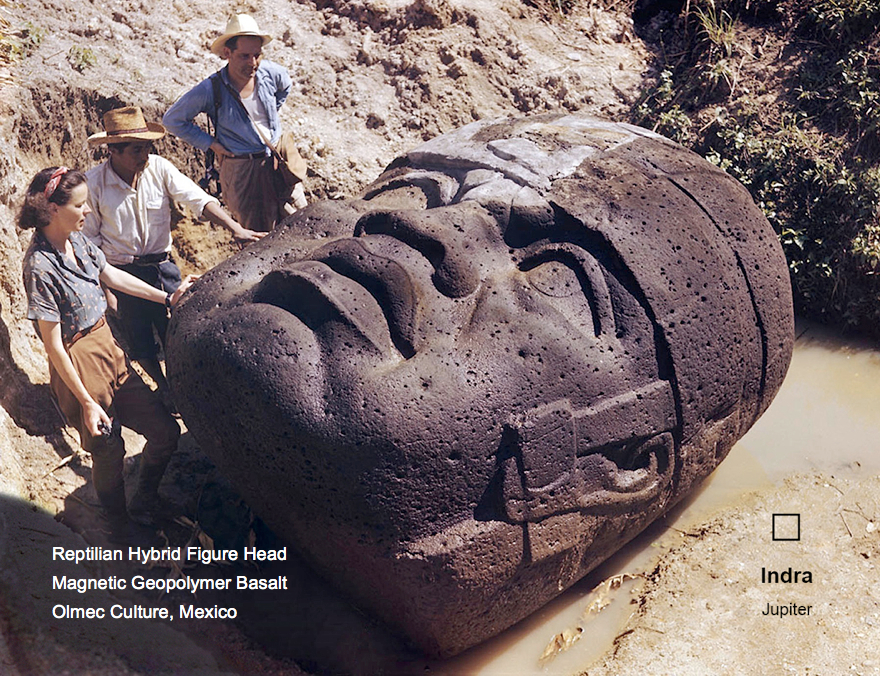
This gigantic portrait head of an Olmec ruler indicates the same ruling class dominance of reptilian hybrids observed at Angkor, and just like the Angkor figures, the Olmecs are wearing large psychoacoustic helmets that act as resonant amplifiers. Like ancient Tibetan metal singing bowls, these helmets were produced from dozens of different metals for inducing hemispheric synchronization in the brain, and a unified biorhythmic pulsation of the heart with the hypothalamus, pituitary and pineal glands.
This special class of psychoacoustic helmet was used exclusively within piezoelectric stone chambers geometrically designed and geopositioned according to the Atlantean quantum function [ zn+1 = zn2 ]. Olmec use of magnetic basalt casting methods in Mexico are identical to basalt pyramids found in Ecuador. Earthenware psychoacoustic whistles from La Maná, Ecuador are formed as human and giant reptilian figures, shown to scale, each wearing customary psychoacoustic helmets. These refined masterworks were loaded with fine magnetic particles of iron, nickel and pyrite that reflect the same exotic admixture applied in reconstituted magnetic basalt of the pyramids for resonant transduction of planetary infrasound.
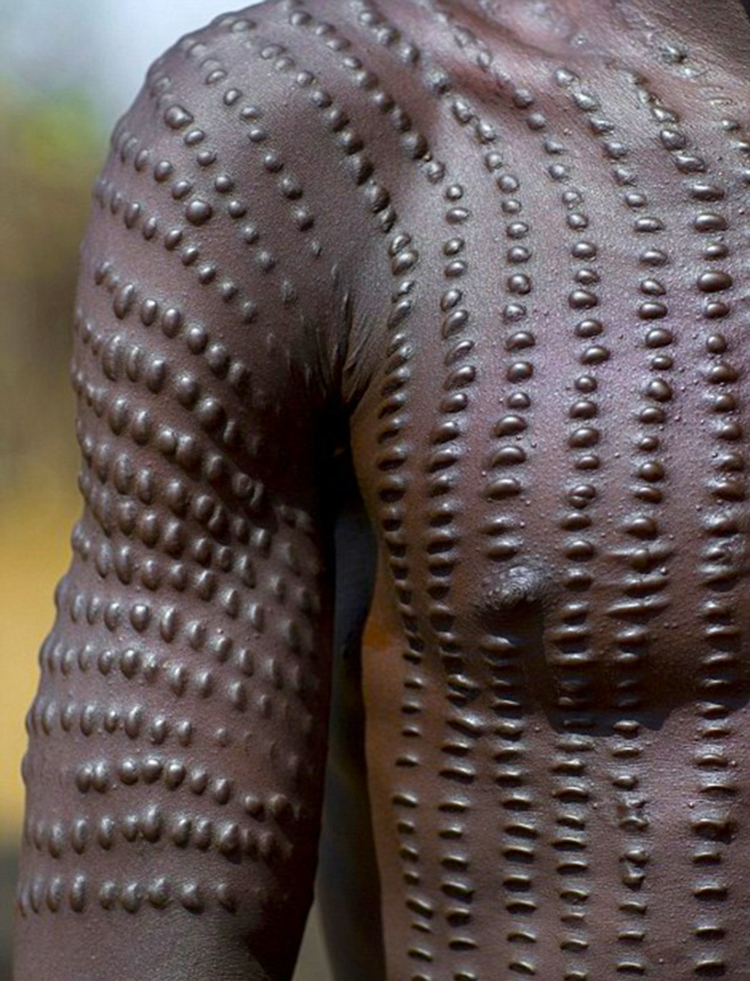
Intriguing traditional practices of Central African cultures also provide strong evidence for reptilian mass hybridization programs operating on Earth since ancient times, as asserted today by an overwhelming majority of victims of 'alien abduction' experiences. Still prominent throughout the Congo is a highly distinctive concept of body beautification designed to imitate the physiology of these reptilian entities.
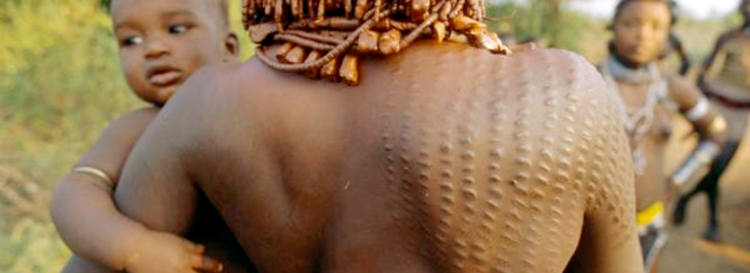
Scarification and tooth sharpening traditions practiced among Central African tribes include bloodletting rituals as rites of passage into adulthood for both males and females. The unusual aesthetic appearance of scar patterning conveys the strong impression of reptilian scales covering the body (above).
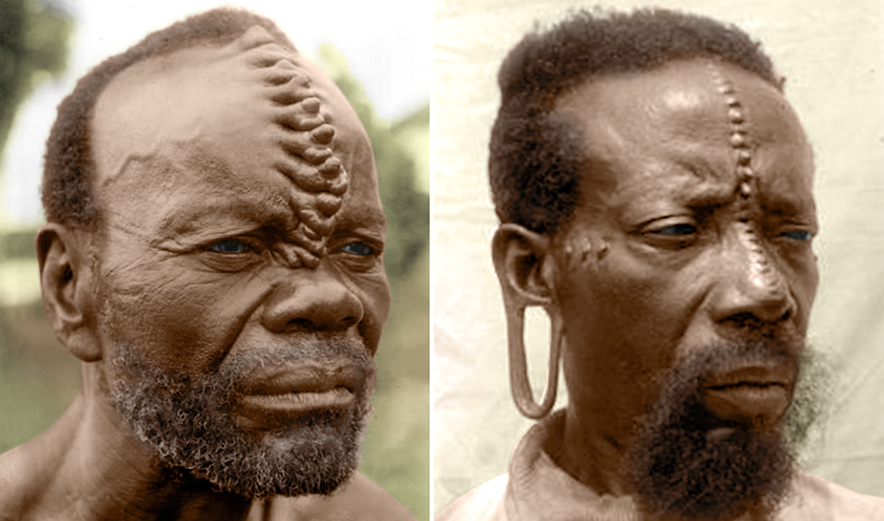
Facial scarification patterns often include a vertical line of bumps cut into the nose and down the center of the forehead (above), closely matching UFO abductees' descriptions and drawings of the giant reptilian humanoid species showing a raised ridge of scales running down the center of the bald head. Traditional masks from various cultures preserve imagery of these extraterrestrial visitors once worshipped as gods.
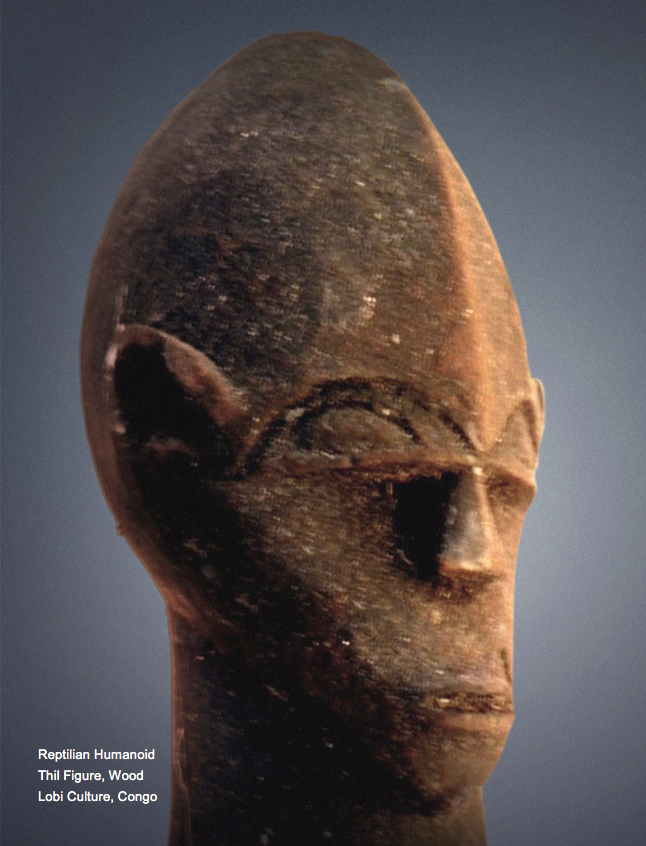
A great many African cultures still possess body modification traditions reflecting reptilian worship practices that correspond to matching backcrossed reptilian craniofacial characteristics, including the Mbalantu, Sara, Soga, Suri, Fang, Mwila, Nuer, Puel, Ashanti, Afar, Mursi and Surma cultures. Votive wood carvings of the Lobi culture of present-day Burkina Faso represent 'spirit beings' called Thil that closely resemble the extraterrestrial reptilian humanoids, displaying vertically elongated skulls (above).
The more extreme forms of bloodletting scarification customs are complimented by unique hairstyles and body painting patterns, as well as facial tattooing and tooth sharpening traditions exemplified by the Afar culture of present-day Ethiopia. Sanskrit hieroglyphs tattooed on the face of an Afar woman with a very long neck and fine braids emphasizing her pointed ears reads: ra upama kar ra su-us upama raua raua , meaning "Granting the highest works, granting whirring of the highest, roaring, roaring..." (below).
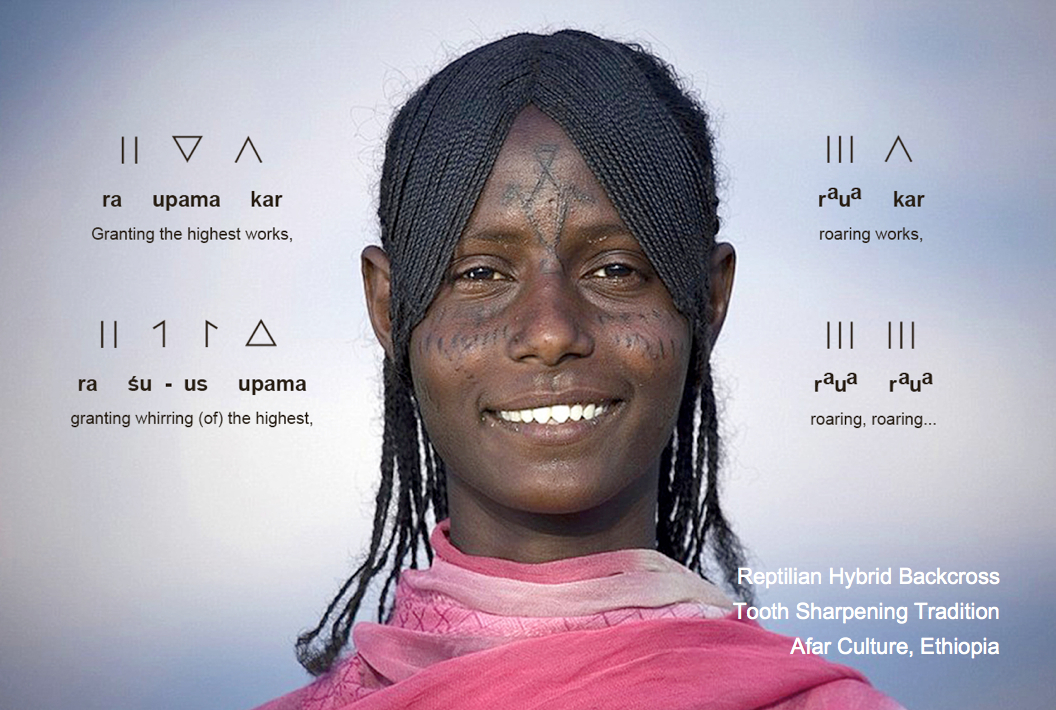
Present-day accounts of reptilian humanoids have also emerged from the Solomon Islands archipelago, called 'dragon-snakes' for their serpentine tails. These predatory beings are also commonly referred to as 'diamond-snakes' for their high-tech use of rare diamond-like crystals only found on the island of Malaita. This crystal is associated with the reptilians' huge, luminous, disc-shaped spacecraft that abduct island residents. Victims are suddenly struck by paralysis in violet HHO plasma beams before levitation into the ships hovering overhead. Fearful residents have also been incinerated by the reptilians' glowing red eyes:
These Diamond-Snakes were... renowned... for their ability to incinerate people with their red eyes, and for kidnapping them. Over generations, many of the village folk had vanished, and as many people had witnessed the Dragon-Snake [spacecraft] taking these abducted people up into its belly, everyone knew they were responsible for their disappearance... [Seeking respite,] the elders and priests carried out... sacrifices and ceremonies to their ancestor gods to stop the Diamond-Snake/UFOs [from] stealing and killing their people...
Michael, one of Festus's sons... told me that a Diamond-Snake [spacecraft] had flown out of a mountain lake in their homeland of Kwara'ae and [a reptilian entity emerged that] used its red eyes to incinerate his grandfather
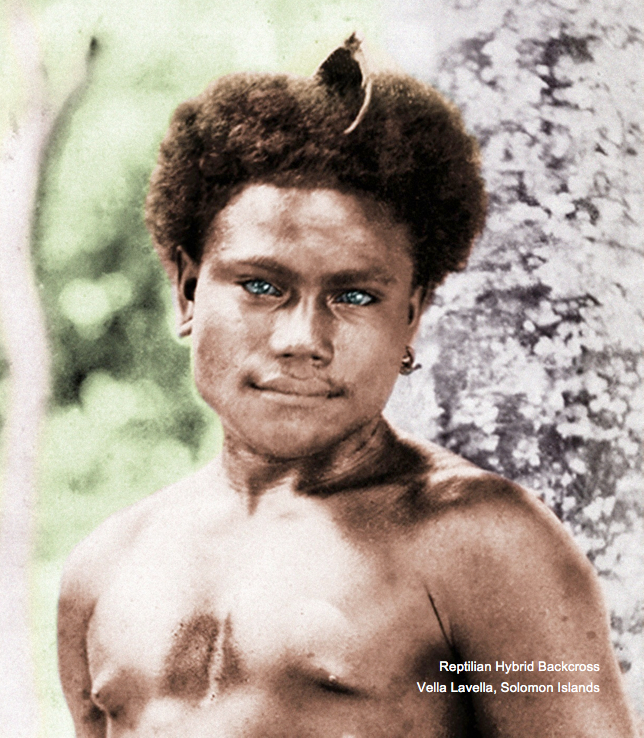
While the origins of Central African body alteration traditions remain misunderstood by ethnographers, the collective cultural awareness of indigenous communities in more remote areas of the world fully clarifies this issue. Captured by John Beattie in 1906, photographs of indigenous faces in the Solomon Islands reveal the same unmistakable craniofacial features seen in ancient temple reliefs. A young man from Vella Lavella Island of the New Georgia Group presents an extremely brachycephalic skull, square jaw and prominent brow ridge overshadowing light blue/green eyes that turn up at the outer corners (above).
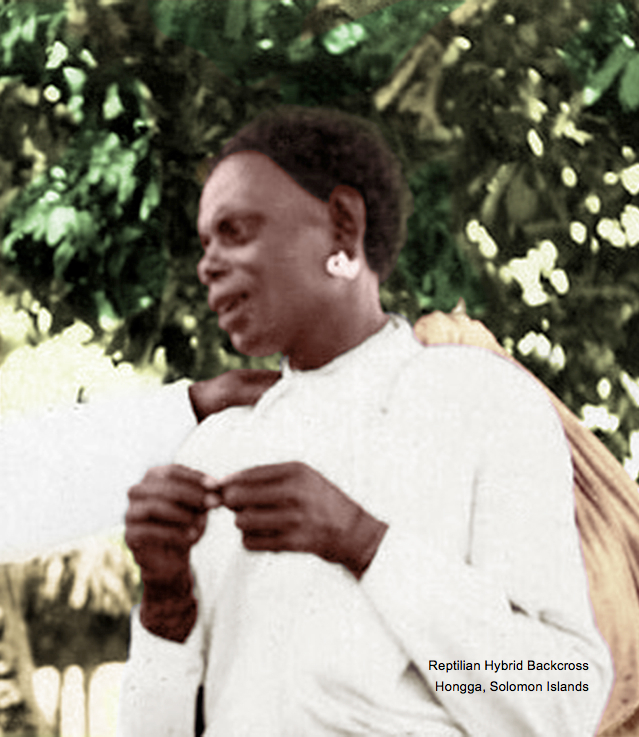
Another photo from the Beattie collection displays the similarly unusual features of John Mansvute, taken in the village of Hongga (above). His large ears stand out from the head, emphasizing an unusually high, trimmed hairline and heavy brow formation over deepset eyes. This combination of craniofacial features is commonly found among indigenous communities of the Solomon Islands and Papua New Guinea that also report extraterrestrial activity by multiple species known to occupy vast illuminated cavern systems below the largest islands of Guadalcanal, Malaita, South Malaita, Makira, Santa Isabel and Choiseul.
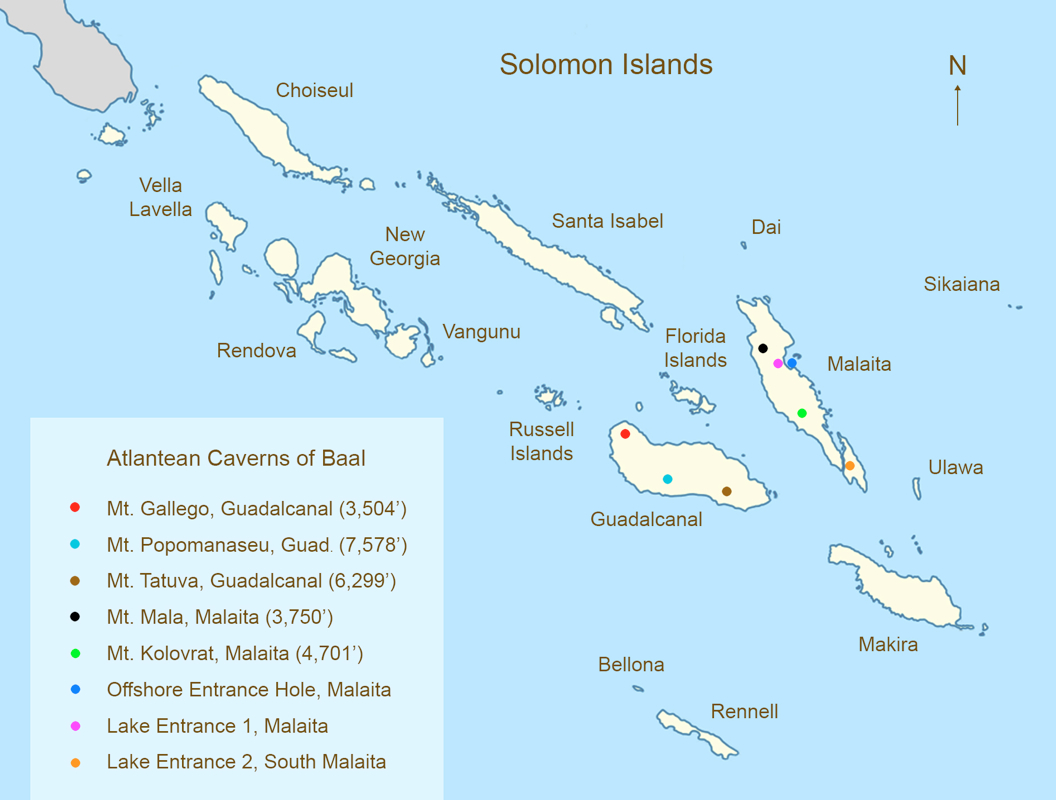
The discoidal plasma ships of these subterranean humanoids are seen almost nightly, entering/exiting highland lakes during transit to and from facilities located within Mt. Gallego (3,504'), dominating the highland interior of Northwestern Guadalcanal, and Mt. Tatuva (6,299') located in Southeast Guadalcanal. Reptilian humanoids are also seen flying low over the rainforest canopy and even stalking the jungle.
Wary island residents commonly witness sightings of hundreds of these giant reptilian humanoids flying in formations above the rainforests of the Solomon Islands. These flying reptoids are greatly feared by those who know of the many fatal encounters and abductions associated with these hyperdimensional entities:
Credible people have been telling me that sometimes at dusk, dawn or during the night they are seeing dozens of a creature that fly in group formations over the jungle going here and there. They all describe the same thing. As they fly along above the jungle, they see a man-like creature with a long tail and a red-glow from upon their back, and a rolling hum from the group as they go over. Many have told me of hundreds of them at a time.
They have been seen at dawn randomly flying around above the fog of the valleys of the big mountains of the interior. They have been regularly spotted in large groups going out to sea and coming back at Central South Guadalcanal. On occasions, they have been seen individually and in groups in the jungle, and they describe their appearance as such: They look like strong Homo sapiens men with greenish-brown scale skin and have a long tail, some apparel, and walk upright.
Physical descriptions of scaly humanoids with long tails offered by many native eyewitnesses closely echo extraterrestrial abduction cases regarding giant reptilian humanoids covertly conducting mass hybridization programming of humanity. Plasma discs are not their only means of flight, as the reptilian humanoids apparently also use individual flight suits with plasma propulsion radiating a red glow from their backs.
Throughout the Solomon Islands, the advanced technological activities of these giant reptilian beings focuses around several high mountain lakes that appear to have been engineered as hidden entrances to subterranean facilities. These sites are well known to locals and appear to be the ancient remains of the Atlantean civilization also utilized by a hairy giant species:
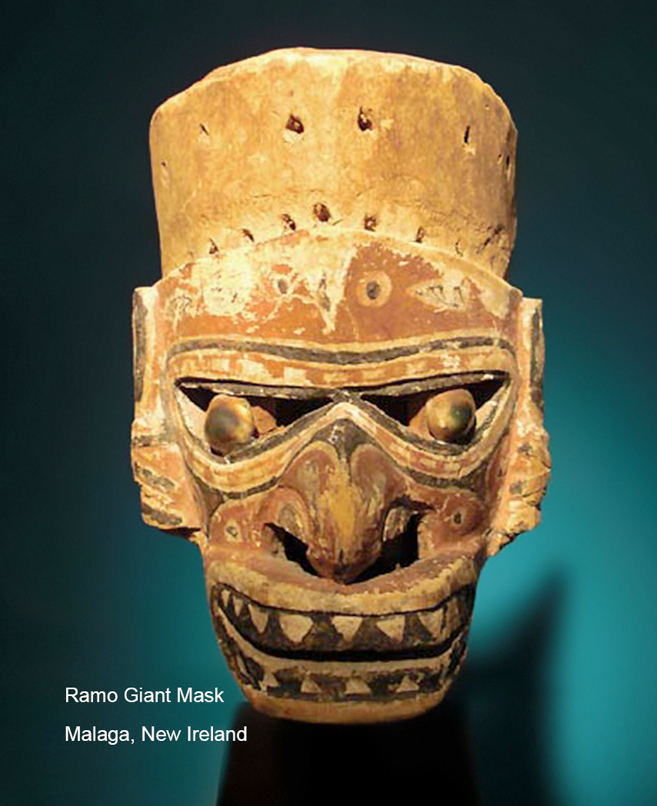
The name 'Ramo' is used by the people of Malaita to describe two different types of [giant] hominoids that once cannibalised their people. Ramo is a Malaitan translation for "man with spiritual powers who eats men"...
More disturbing details concerning cannibalism practiced by the hairy Ramo giants on the human beings of the Solomon Islands was also shared by locals who knew their horrifying predatory habits all too well:
On many occasions, I have been told the giants were renowned for being able to slow down a fleeing potential meal by using thought alone... The way it has been described to me is that they have the ability to slow the person down through their thoughts and somehow paralyse them with fear just before they capture them.
The Ramo giants are renowned for being so strong that they can rip limbs right off with great ease. Apparently in village raids they would sometimes start to eat their victims by holding them upside down and splitting their two legs apart to rip the body to pieces, because there is a weak spot in the hips. What they didn't eat right then and there they would put in their big sago palm bags (that their women made for them) to take home to their family.
Terrifying predatory tactics used by the enormous, hairy Ramo giants are not restricted to more remote mountain areas, but have also been used to destroy Honaira, a large port town on Guadalcanal Island:
One night, during the 1960s, for some reason that I never discovered but can speculate why, the Guadalcanal giants went through Honaira and smashed the town to pieces. This is a well-known story of recent Guadalcanal giant history. Mind you, there are plenty of them.
Predatory domination and control of human populations in the Solomon Islands by the giant humanoids has secured the remote, mountainous regions as giant territory, where even the animals avoid using the giants' jungle pathways. Adventurous residents in these areas report an abundance of ancient potsherds and stonework. Paleo-Sanskrit hieroglyphs are engraved into the megalithic ruins of Northern Malaita:
Around a mountain near "Mt. Mala" of North Malaita's interior, is a perfectly fitting large stone blocked wall path spiralling around the mountain. This path leads to a flat area on the top of the mountain of where another large stone blocked wall separates to a higher split-level flat area where an alter can be found. Some hundred metres further on is a burial site that has a perfectly flat approximately 18' x 6' x 1' stone upon it. The bush people further away from that area say that a Ramo of great importance is buried there. There are also hieroglyphic inscriptions chiselled into these stone block walls. Several years ago when they were cutting the bush back a little to expose this area more, they also found pottery and other items.
Descriptions of the megalithic platforms and extensive wall formations of the Mt. Mala area of Northern Malaita exactly match the advanced polygonal geopolymer stonework of the Atlantean global civilization responsible for the building of pyramids all over the world. Several residents fortunate to have survived abduction during the giants' raids reported daylight-like illumination of complex arrangements of cavern systems below the Solomon Islands, achieved through resonant HHO plasma formation in the chambers.
Descriptions of the hieroglyphic texts engraved into the stonework and ceramic objects from these ancient sites comprises linguistic evidence that is directly supported by the discovery of similar Paleo-Sanskrit petroglyphs located throughout the landscapes of New Caledonia and Vanuatu; neighboring large island chains situated to the southeast of the Solomons where similar extraterrestrial activities are reported.
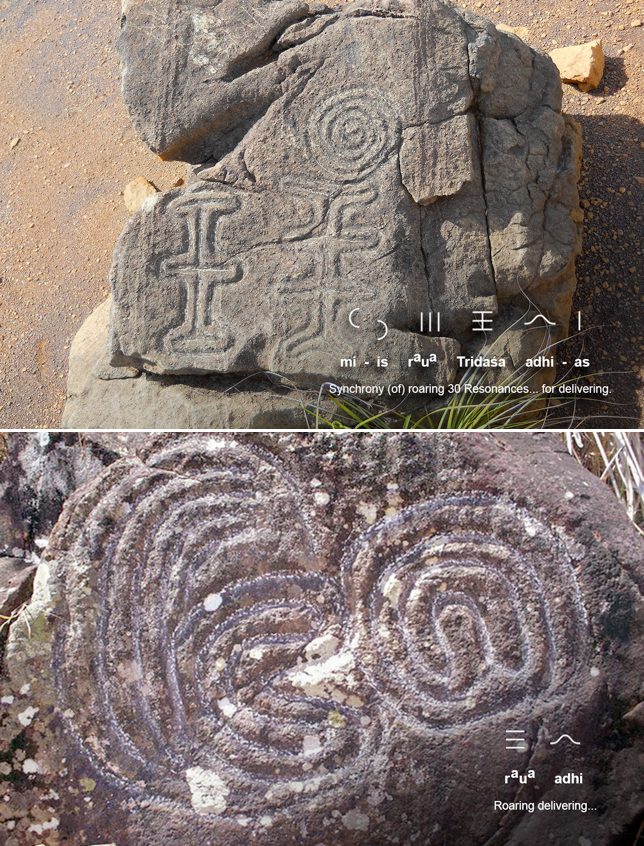
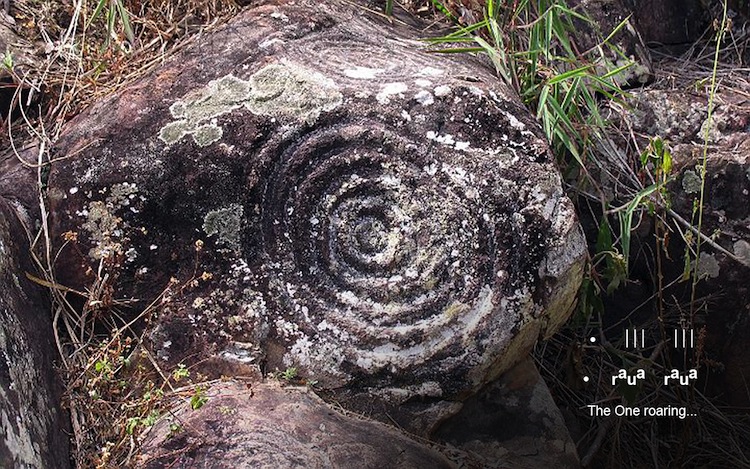
An ancient geopolymer basalt block discovered on a remote beach in New Caledonia is marked with an Atlantean votive phrase praising biorhythmic synchronization endowed by infrasound resonance: mi-is raua Tridasa adhi-as , meaning "Synchrony (of) roaring 30 Resonances... for delivering" (opposite, top).
Another beautiful example of hieroglyphic inscriptions on artificial basalt stonework from Katiramona, New Caledonia provides a basic phrase reading: raua adhi , meaning "Roaring delivering..." (opposite, bottom). Concentric circles inset into geopolymer boulders near a small waterfall reiterate a similar votive statement referencing the sacred sound of running water, reading: * raua , meaning "The One roaring..." (above).
These and many other similar petroglyph texts from the Pacific Islands closely match Atlantean hieroglyph ligatures at a sacred Paleolithic river temple site located in present-day Altavista, Mexico. Inscribed hieroglyphic texts from the same Atlantean era belonging to the Ohum culture of modern-day Ecuador and Peru reflect the same linguistic heritage of the advanced pyramid-builders of Indonesia and Micronesia.
The large remote island nations of the Pacific Ocean and Papua New Guinea were once conjoined during the Paleolithic period of Atlantean civilization when global sea levels were several hundred feet lower.
Common cultural traditions practiced throughout Papua New Guinea, Indonesia and Malaysia pay homage the spiritual powers of ancestral community members by preserving and decorating the skulls of the deceased. This practice also extends to the skulls of victims of cannibalism and ethnic wars that periodically disrupt the harmonious flow of village social life in the tropical rainforests:
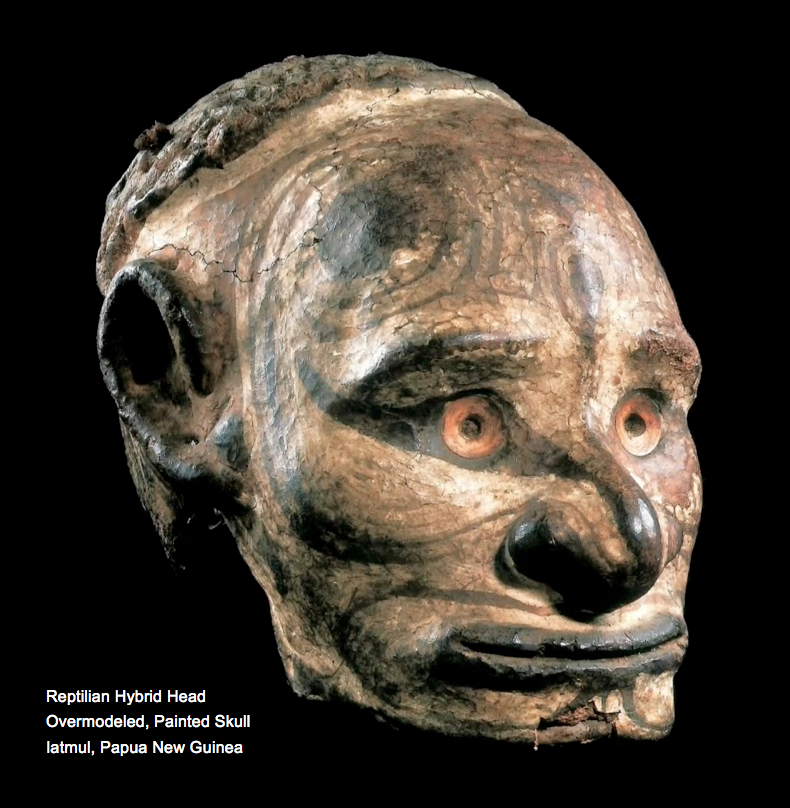
The Iatmul people of Papua New Guinea kept the skulls of their ancestors which, once overmodeled with clay and then painted with designs, became protectors of the community. They were used in funerary and fertility ceremonies where they were displayed atop of poles. The skull of the dead ancestor was decorated to imitate the facial painting of the deceased. Skulls of headhunting victims were similarly decorated and kept as trophies.
Many well-preserved ancestor skulls collected by ethnographers over the last century from the Iatmul people of the Sepik River basin in Papua present strong features of reptilian hybrids (above).
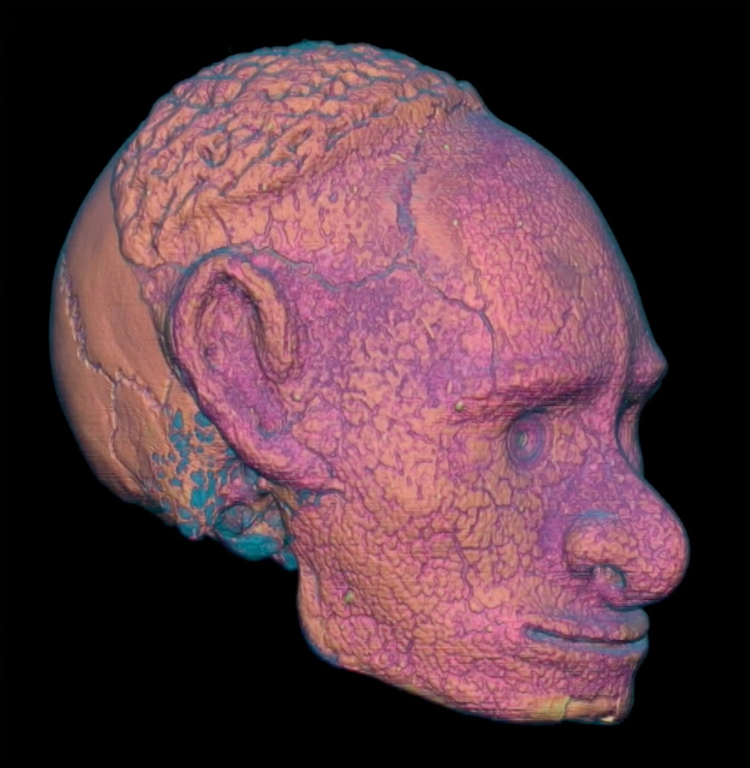
A high-resolution CT-scan of an unusually formed Iatmul ancestor skull was obtained by M. Ghysels, providing comprehensive views of both the unusual forms presented by the skull, as well as the unusual facial features artistically overmodeled in a geopolymer paste mixed from clay and ash. Traditional Sepik artists specifically rendered a very wide mouth with thin lips; large, pointed ears set very high on the head, and a strange receded hairline that may explain the origin of common male baldness patterns.
A study of indigenous faces from the Solomon Islands supports the contention that the distinctive features are an expression of reptilian/human hybrid genes present in various populations of Pacific Islanders. The photograph of John Mansvute, taken in 1906, displays the same characteristics of a heavy brow and high, pointed ears that stand out from the head, along with the distinctive receded hairline. As the giant reptilians are entirely hairless --having scales-- changes in hair patterning may be expected in hybrid backcrosses.
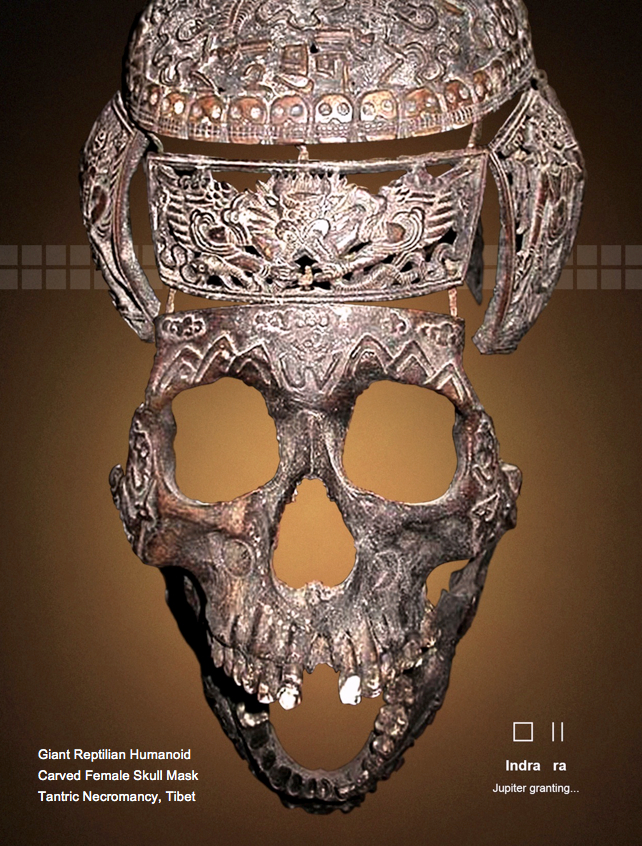
Tantric Buddhist relics from ancient cave systems in Tibet provide fascinating evidence for the presence of extraterrestrial giants in underground chambers created by the Atlantean civilization over 13,000 years ago. Monstrous skulls belonging to the giant reptilian humanoids have been ornately carved as necromancy masks for trance divination practices. Both male and female specimens display giant size, incisor fangs and refined Tantric imagery, emphasizing demonic motifs with embedded Sanskrit glyphs.
Rows of skull icons circumscribing the giant skullcaps were designed as repeating hieroglyphic mantras reading: * adhi * Indra ra , meaning "The One delivering, the One, Indra granting..." (above). The masks' forehead panels were intricately engraved with winged reptilian/avian demons holding double-headed DNA serpents in their hands and beaks, representing the reptilian humanoids' advanced technological means for acoustic levitation, spaceflight and interplanetary genetic blending of various humanoid species.
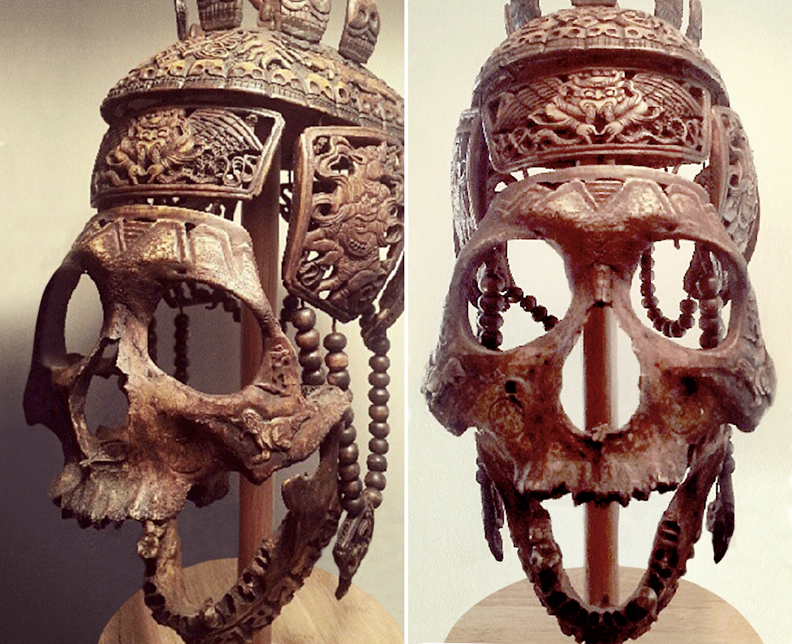
The skulls' heavy brow ridges are engraved with scenes depicting sacred mountain peaks and clouds forming votive glyph ligatures, reciting: Karah Karah Karah jani Karah Karah Karah , meaning "The Creator, the Creator, the Creator..., production (of) the Creator, the Creator, the Creator..." (above).
Glyph pairs engraved on either side of the nasal aperture show the crescent moon and full moon, yet also convey the sacred name of the Preserver and Sustainer of Life: Vis-nu , or "Vishnu" --representing the field of infrasound resonance. An octagonal dharma wheel mandala engraved at the crown chakra of the giant skull mask references the Atlantean quantum function [ zn+1 = zn2 ] defining the planetary infrasound field.
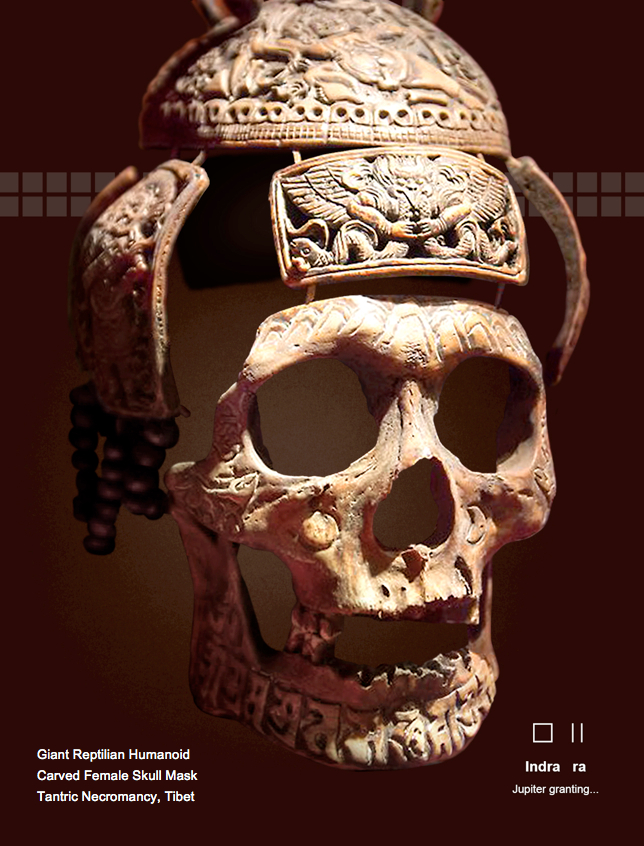
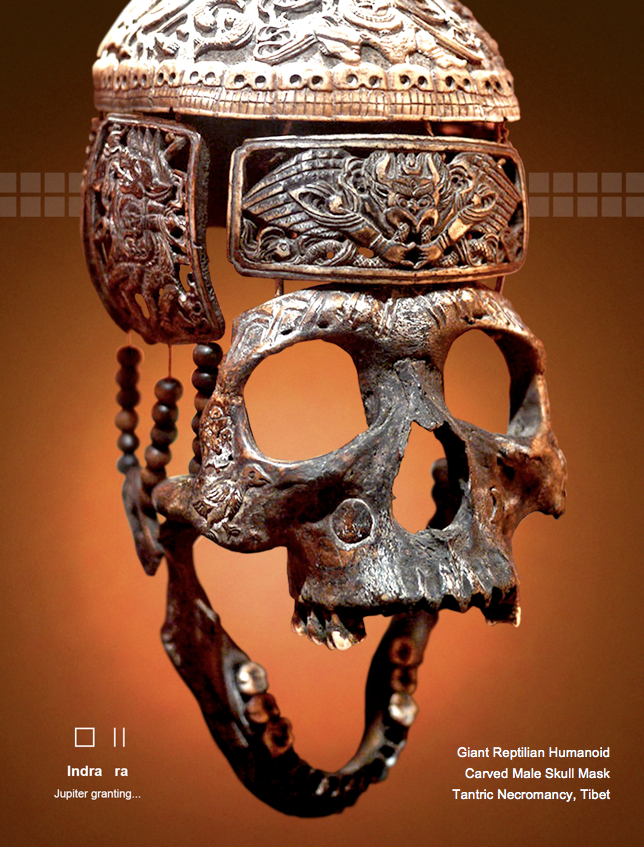
Another reptilian skull preserved as aTantric Buddhist relic is a large female hybrid specimen with incisor fangs that was not carved into a mask but shows the same iconography. Prominently displayed on the sides of the skull are winged avian/reptilians and the Goddess Kali (below).
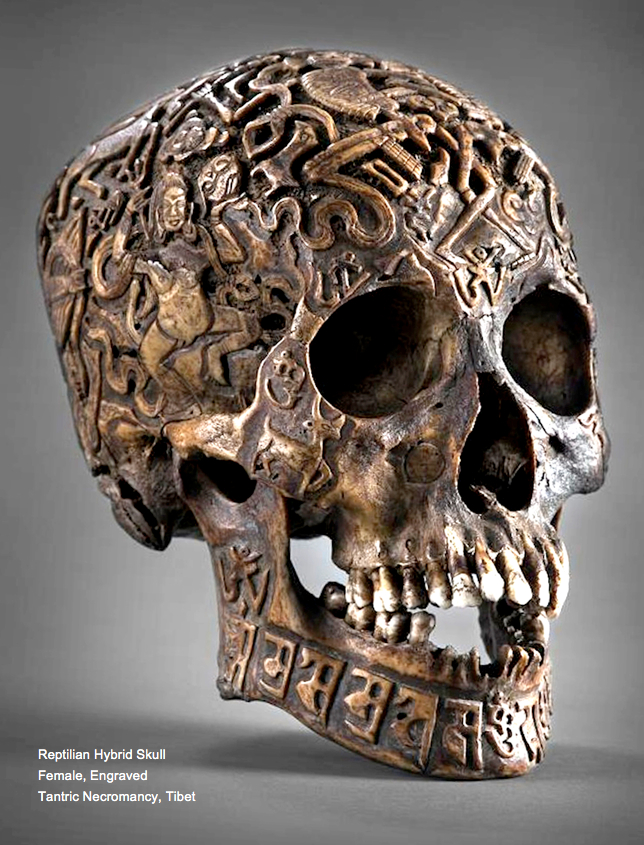
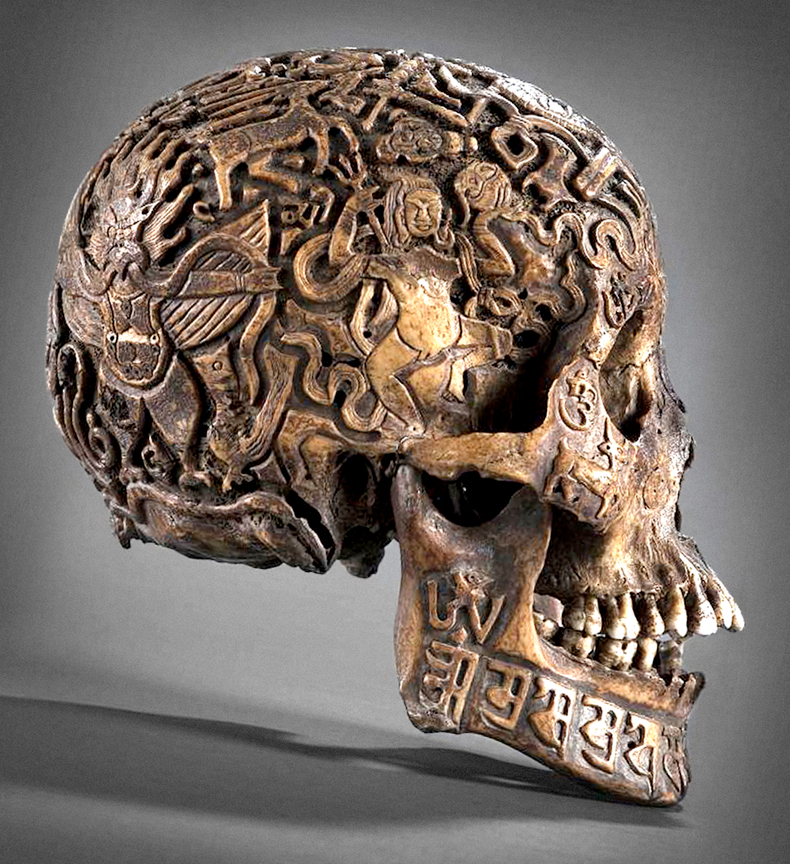
As the Destroyer, Kali dances with pairs of writhing snakes representing DNA helices, from which we can make the obvious inference that the ancient Sanskrit traditions of Tibet remain close to the spiritual roots of the high Atlantean knowledge concerning these reptilian humanoids mass genetic manipulation of human populations on a global scale, as reported by so many victims of extraterrestrial abduction phenomena.
The well documented Tibetan relics offer several examples of giant reptilian crania that were especially carved into necromancy masks to channel the spiritual essence of the deceased humanoid being that had once presented itself to human beings for worship as a false god. Complete skeletal remains of this giant species are much more rare in the archeological context, but do exist in significant numbers.
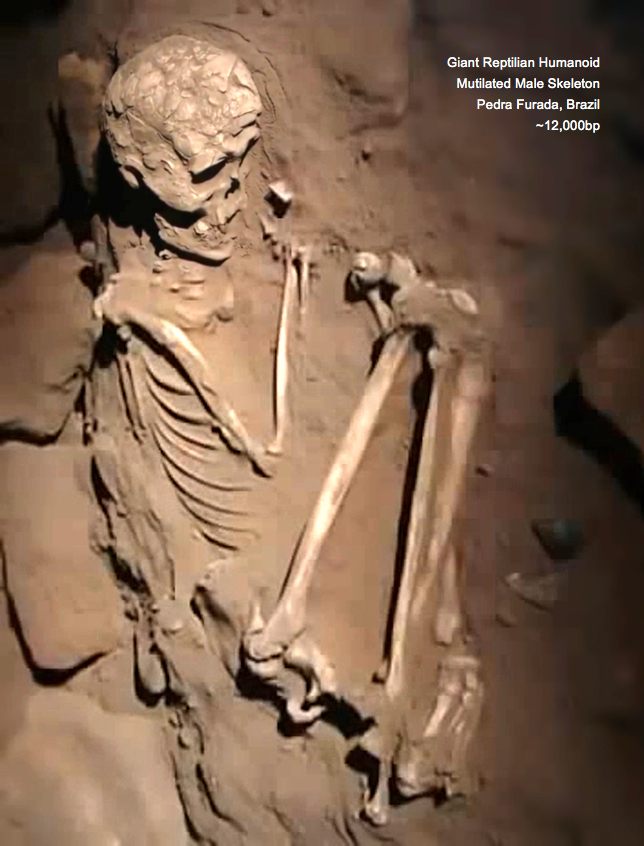
One such example is the well articulated, nearly complete skeleton of a giant reptilian humanoid that was recently excavated at the Toca do Boquierão da Pedra Furada rock shelter, located in Northern Brazil dated to ~12,000bp (above). Examination of the unusual specimen reveals a very tall individual standing well over 6' in height (>183cm), exhibiting extremely thin, short arms that are strangely contrasted by long, thin legs and very long, narrow feet. The large size of the fractured skull, in combination with its many distinctive non-human facial characteristics, closely conform to the giant reptilian humanoid skulls of Tibet.
The heavy brow ridge and large cheek bones are matched by the same square, oversized mandibles that are evident in greater detail among the Tibetan specimens. Clear signs of physical trauma and violence are evident as multiple healed fractures appear as boney growths on the exposed portion of the right humerus and perhaps on the pelvic bone. Signs of violence to the corpse after death are also present.
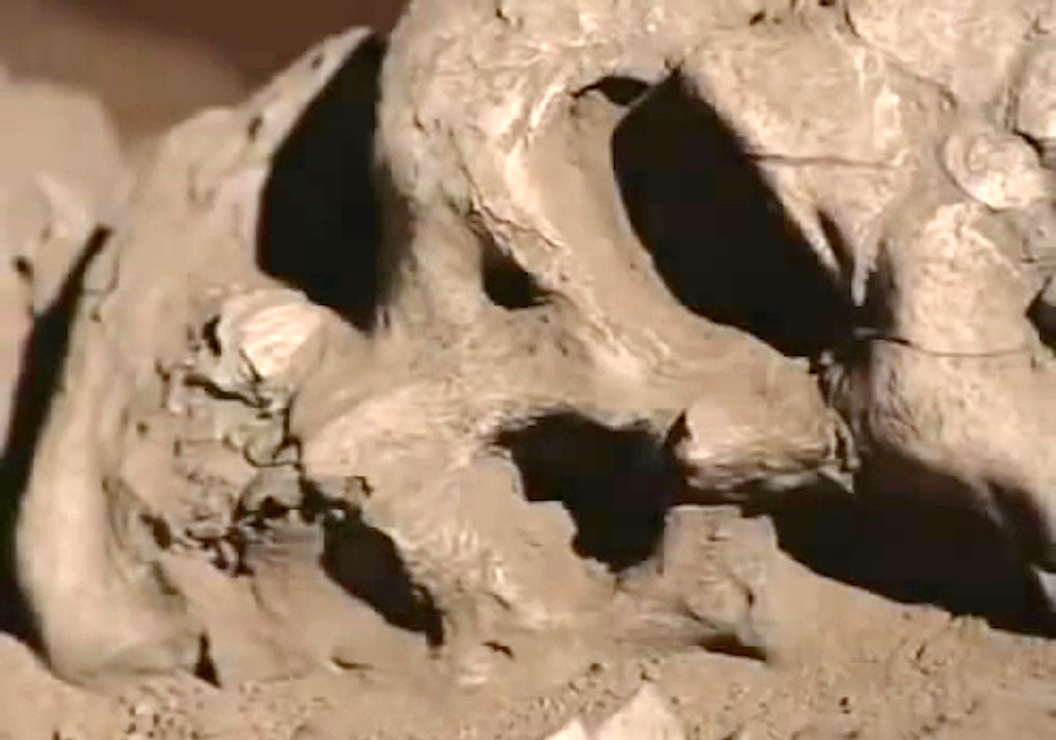
The giant reptilian humanoid's skull has been shattered into dozens of fragments that have not been scattered about the body, but appear to have been incurred post-humously just prior to burial in a shallow pit lined with several large, flat stones. The head appears to have been propped up on a stone base and battered with blunt force many times in a ritual mutilation that suggests this skeleton, and the many associated skeletal remains, were captured and killed together by an adversarial social group.
Evidence gathered from this violent burial scenario directly supports the contention that worship of giant reptilian humanoids and their human hybrid progeny involved human sacrifice that was later condemned.
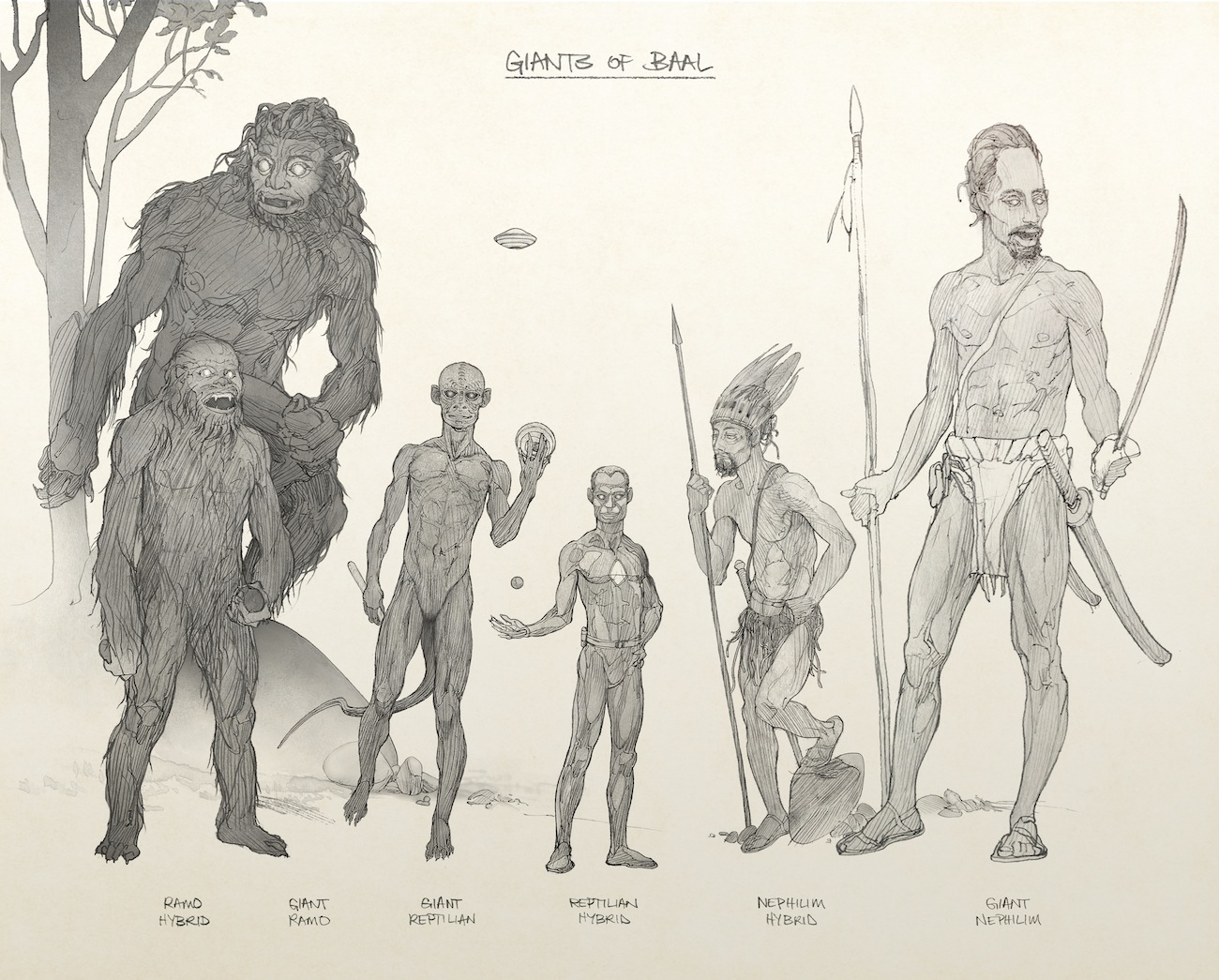
The complex picture of terrestrial human genetics can be immensely clarified by establishing complete genetic profiles for the various extraterrestrial species of giants and dwarves hybridized with humans during the Atlantean era. Biblical terms for the technologically advanced reptilian giants directly relates to their coersion of human worship as Baal, a Hebrew word meaning "false god" (or Baalim; "false gods").
Known collectively as the Baal forces in Atlantis, this diverse group of non-human species were described by trance medium Edgar Cayce in a reading given on April 29, 1932 (Reading 364-11):
Q: Please give a few details regarding the physiognomy, habits, customs and costumes of the people of Atlantis...
A: These took on many sizes as to stature, from that as may be called the midget to the giants --for there were giants in the Earth in those days, men as tall as (what would be termed today) ten to twelve feet in stature, and in proportion --well proportioned throughout.
The giant species of extraterrestrial humanoids that occupied the Atlantean lands were intent on controlling the use of psychoacoustic temples, ultimately destroying the Atlantean civilization and many lands now submerged below the Atlantic and Pacific Oceans. In all regions of the world, Atlantean cavern systems with daylight-like artificial illumination are still occupied by reptilians, nephilim, ramo giants and their hybrids, together comprising six distinct giant humanoid species (illustrated above).
The reptilian giants possess vertical pupils offering enhanced depth perception of apex predators. The reptilians and ramo giants, as well as their human hybrid variants possess sensitive infrared vision for nocturnal predation. Abundant reports of the red glowing eyes of these giants attest to the bioelectrically induced effect of ionization beams emitted from hovering discs that also paralyze their fleeing prey.
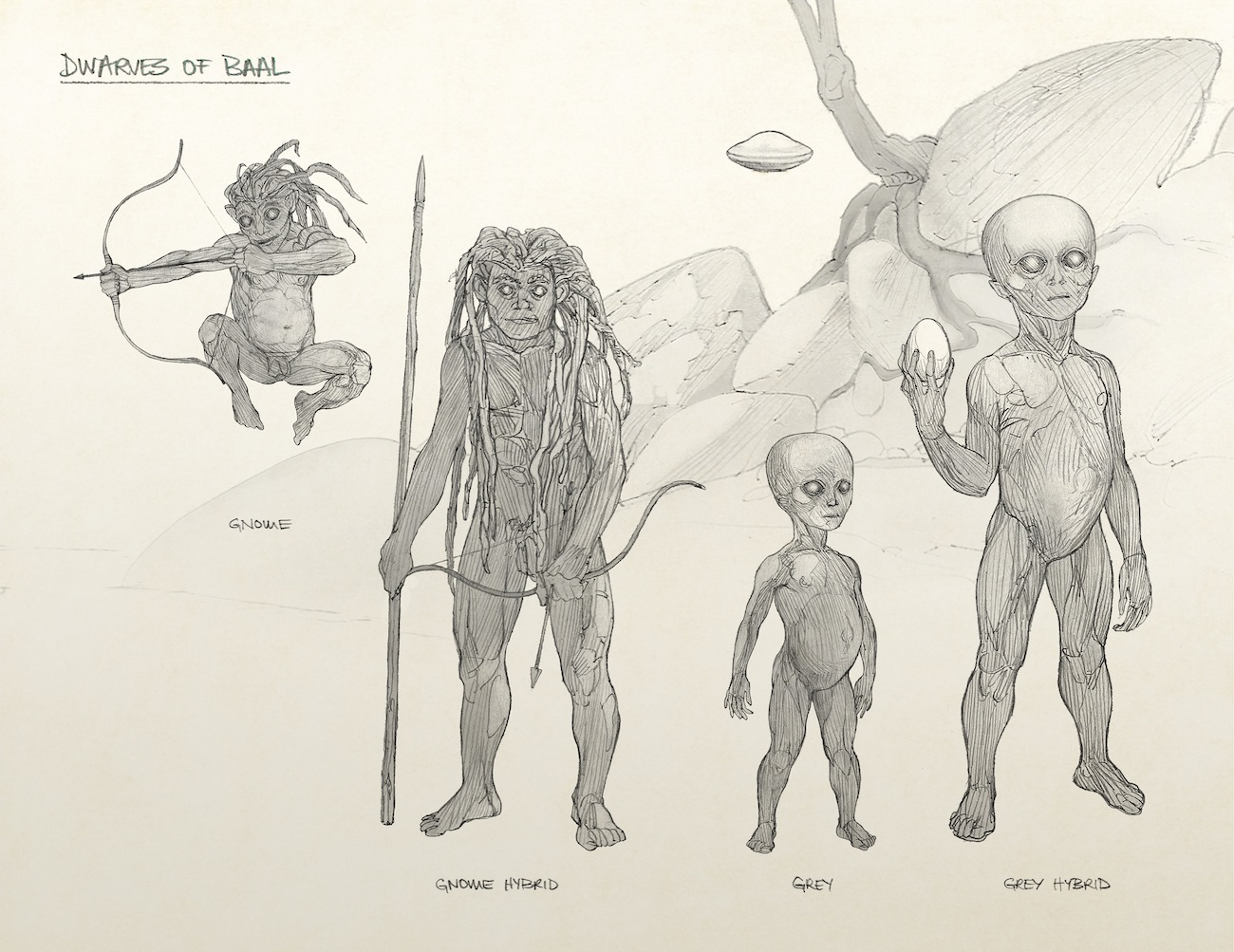
In referencing the presence of 'midgets' in Atlantis, Cayce had identified the various dwarf species among the Baal forces that include greys and gnomes and their respective human hybrid species, comprising four distinct dwarf humanoid species (illustrated above). Identified altogether, this exoplanetary group comprises ten extraterrestrial species known as the Baal forces --'Baal' refers to the reptilian overlords in particular, who transport and hybridize these many species with terrestrial humans.
The reality of the Baal forces was subliminally programmed into the Star Wars movie series that includes a sasquatch character who pilots spacecraft and a wise green gnome character with spiritual powers of superstrength and superagility, whose name corresponds the Sanskrit root word for "warrior": yodha.
Sci-fi imagery conveyed by mass media facilitates government dismissal of UFO sightings and the entire reality of extraterrestrial abduction experiences as fantasies invented by movie fanatics. Superheroes in tights featured in comic books and films mask the reality of aerial humanoids in fourth density apparel.
The reality of exoplanetary genetic manipulation of Earth humanity by advanced technological means far beyond our present understanding is supported by scientifically verified cases of contactees who have been involuntarily subjected to experimental hybridization processes. Eyewitnesses state the operations are conducted in spacecraft vehicles of various types, equipped with examination tables and HHO plasma cauterizing tools for various surgical procedures. This much has been deduced by investigators of animal mutilation phenomena, also corresponding to known predatory habits of the giant reptilian humanoids.
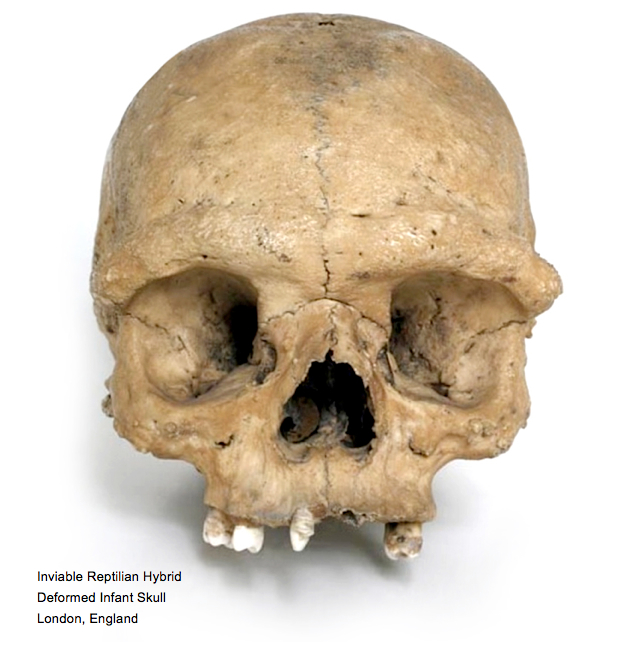
Another bizarre manifestation of the hidden presence of reptilian hybridization programs are rare instances where terrestrial human females give birth to deformed hybrid infants, likely resulting from rape by reptilian humanoids. A tiny skull examined in London, England corresponds to a deformed hybrid offspring of a reptoid rape, presenting incisor fangs and anomalous sutures bisecting the frontal bone. X-ray imaging of the skull reveals fused molar roots and low-density cancellous bone forming the thick brow ridges. These unusual cranial features correspond to those observed of backcrossed hybrids from many ancient sites.
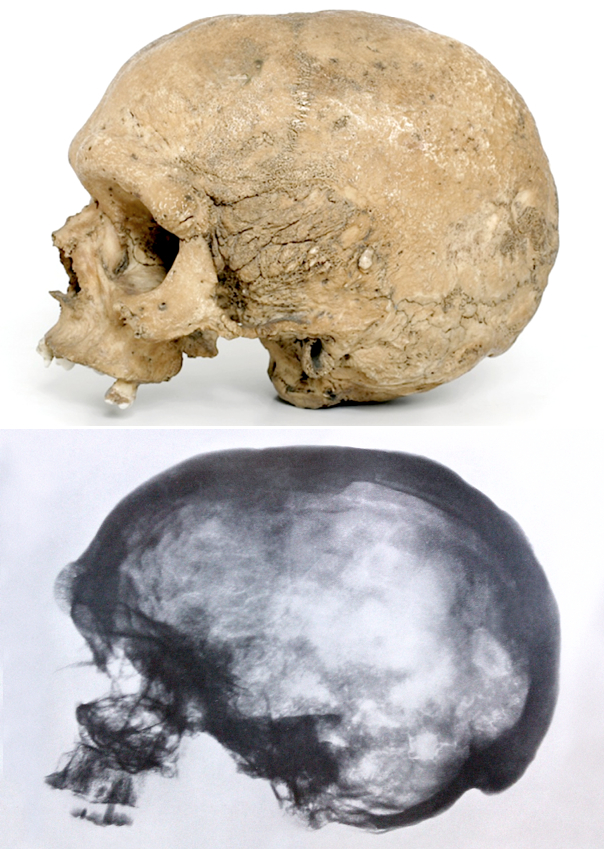
Evidence for hybridization of terrestrial human beings with the diminutive gnome species is as abundant as the cultural and genetic evidence of the reptilian giants and their hybrids. Surviving populations of 'pygmies' living in remote rainforests in Africa, Southeast Asia and the Pacific region represent isolated populations of backcrossed gnome hybrids, commonly known as the 'hobbits' of ancient lore.
Ancestor skulls preserved for ceremonial display by the Asmat tribe of Irian Jaya, Indonesia, present all the characteristic miniature craniofacial features of hobbit backcrosses that closely resemble the tiny Flores Island humanoids discovered during deep excavations at Liang Bua in 2003 (below). Analysis of morphological traits of these skulls suggests intermixing of the hobbit species with the human species to produce the pygmy races. As with sasquatch, genetic compatibility between hobbits and humans confirms they are a hybrid species exhibiting gnome nuDNA and human mtDNA.
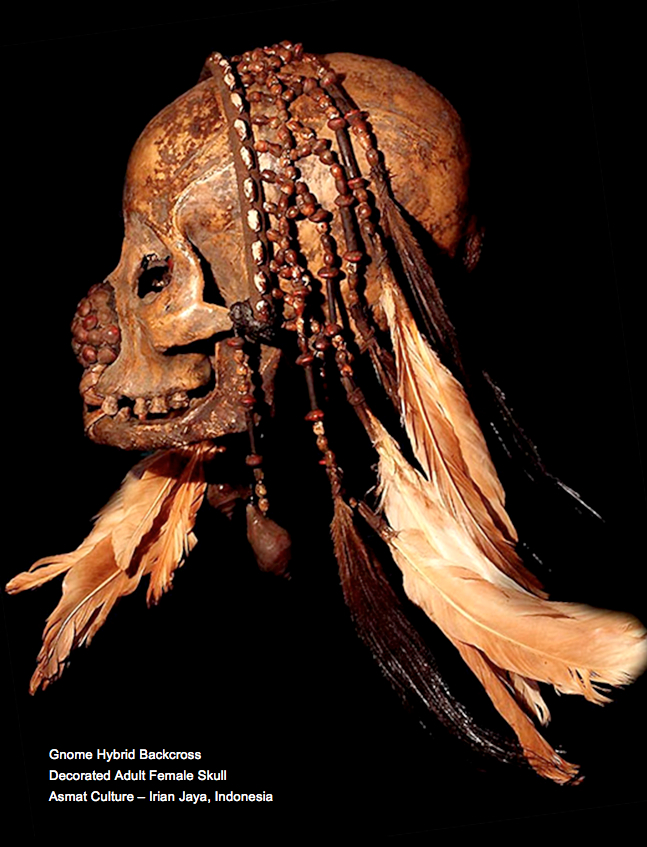
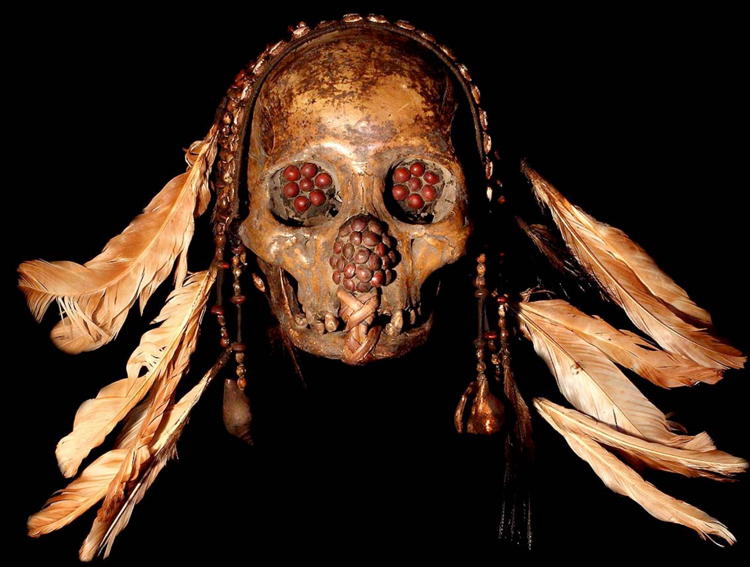
Traditional customs of pygmy races located in remote territories situated on disparate continents also supports the gnome/human hybridization hypothesis. Gnomes are known to indigenous cultures all over the world as tiny carnivorous humanoids that naturally possess sharp, needle-like teeth that have not yet been recognized as the inspiration behind tooth sharpening traditions practiced by undersized rainforest tribes for many thousands of years in Africa, Southeast Asia and the Pacific region.
The natural dagger-like teeth of troglodytic gnomes are imitated by cultural body modification practices of the Ba'ak pygmies of Cameroon, who commonly file the teeth down before puberty (below). This same tooth sharpening tradition is also present among several other groups of backcrossed hobbits thriving in the forests of Central Africa, including the Zappo Zap culture of the present-day Congo region.
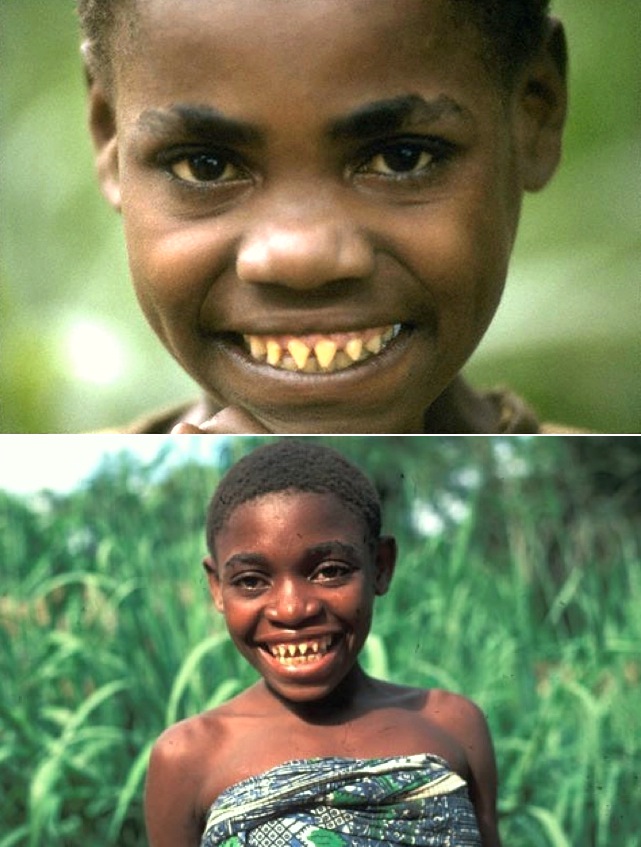
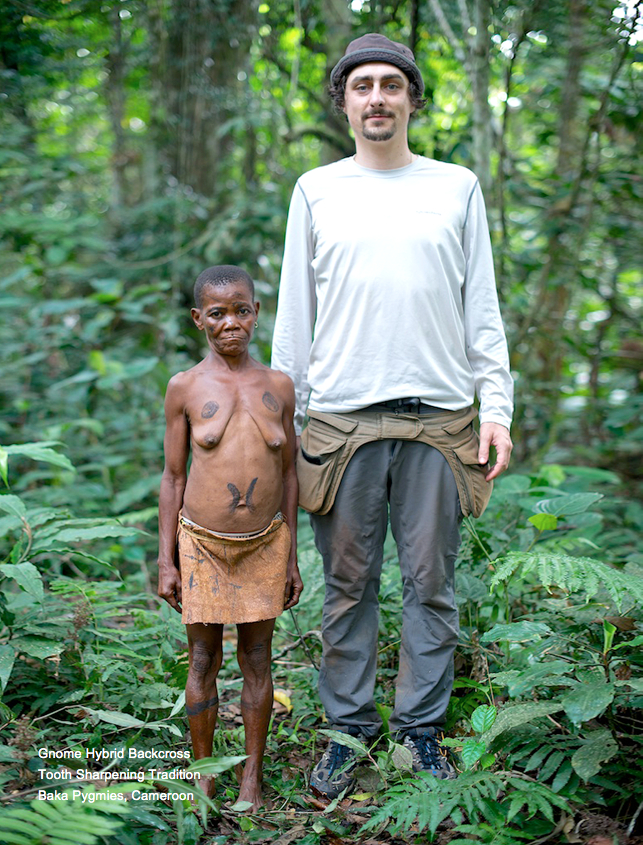
While the hidden presence of African hobbit populations living in subterranean communities below the bedrock of Central Africa suggests hybridization of African human females with gnomes, far removed hobbit populations residing in caves in Southeast Asia and the Pacific have also confirm Asian females have also been hybridized with gnomes. Tales of white-skinned hobbits in Ireland suggest that many human haplogroups have been hybridized over millennia of genetic manipulation conducted by the reptilian giants.
The hallmark hobbit backcross custom of tooth sharpening is also still practiced by the surviving members of the Mentawai culture of the remote rainforests of Siberut Island, West Sumatra, Indonesia. The Mentawai are an undersized race that has preserved the ancient cultural practice for modifying the teeth of backcrossed gnome hybrids to give the natural appearance of full-blooded gnomes (below).

While known pygmy populations have certainly been surveyed by genetic studies for classifying basic haplogroup relationships, these have not been entirely understood. Total clarification of the unique genetic heritage exhibited by backcrossed hobbit populations will only be revealed by genetic sequencing of the gnome genome, just as accomplished by the Ketchum group in the case of the sasquatch hybrids.
Compilation and analysis of relevant reports of abduction by non-human entities that have been serially endured by terrestrial human populations worldwide must be correlated with genetic surveys of the five extraterrestrial Baal species to inform comprehensive conclusions concerning human origins on Earth.
In all cases involving exoplanetary hybridization projects, human females of all haplotypes from every region of the world were selected as surrogate mothers for forced participation in a grand operation that remains largely imperceptible to the masses of humanity. Genetic and cultural evidence strongly implicates the giant reptilian humanoids as the Baal geneticists, conducting an ongoing hyperdimensional mass hybridization program involving worldwide genetic manipulation of terrestrial humanity, only now being recognized as an exoplanetary gene flow dynamic extending far back into the Atlantean era.
Continue to Hybrid Dragon Kings
From the book Baal Hybrids
Copyright 2015 Alexander Putney